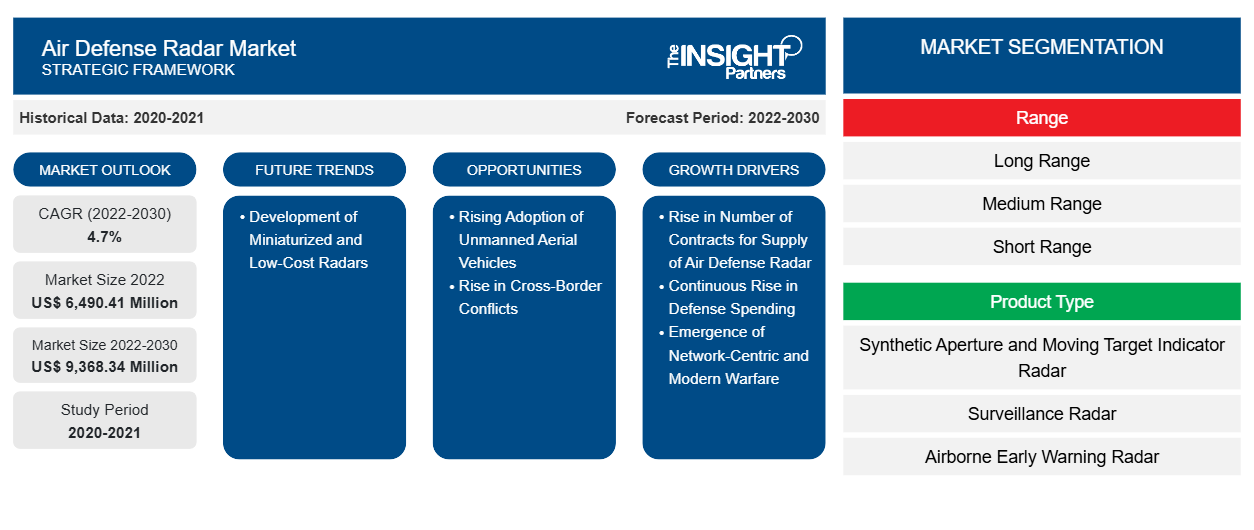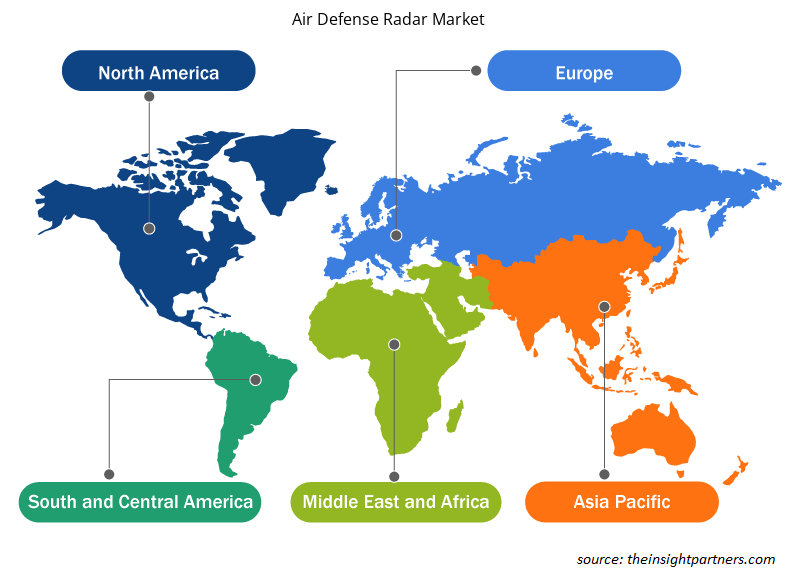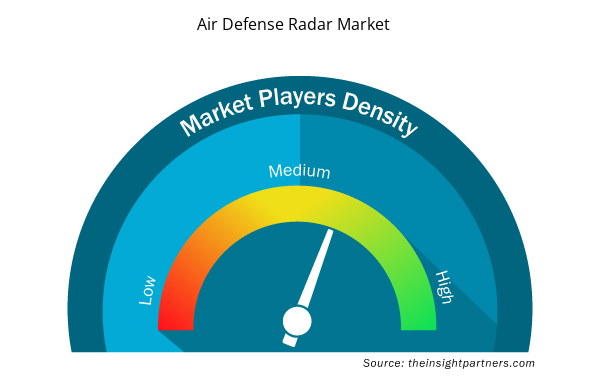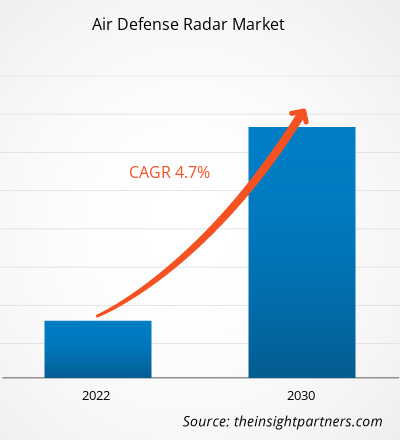Air Defense Radar Market size is projected to reach US$ 9,368.34 million by 2030 from US$ 6,490.41 million in 2022. The market is expected to register a CAGR of 4.7% in 2022–2030. The development of miniaturized and low-cost radars is likely to remain a key air defense radar market trend.
Air Defense Radar Market Analysis
Jamming and spoofing techniques can degrade the situational awareness provided by air defense radar systems. By interfering with radar signals or providing false information, these techniques can mislead operators and decision-makers, leading to inaccurate assessments of the threat. Reduced situational awareness hampers the ability to effectively respond to airborne threats and can jeopardize overall mission success. Radar system manufacturers and operators continually develop countermeasures to mitigate the impact of jamming and spoofing techniques. These countermeasures may involve advanced signal processing algorithms, adaptive waveform generation, or the integration of complementary sensor systems. However, as countermeasures evolve, adversaries may develop more sophisticated jamming and spoofing techniques, necessitating ongoing investments in research and development. Mitigating the impact of jamming and spoofing techniques often requires the integration of additional technologies and systems into radar architectures. This can increase the cost and complexity of air defense radar systems, making their procurement and maintenance more challenging. Organizations must invest in robust countermeasure capabilities, training, and regular updates to stay ahead of evolving jamming and spoofing techniques.
Air Defense Radar Market Overview
End users of air defense radars can vary depending on the specific application and the organization responsible for defense and security. It can be utilized by military forces such as national armies, air forces, and naval forces and border security agencies. It can also be used in military air traffic control systems. In addition, air defense radars play a crucial role in the air defense systems of NATO (North Atlantic Treaty Organization) and allied forces. These radars also maintain the defense and security of EU member countries, providing situational awareness and contributing to joint defense operations. Also, a few end users of air defense radars can vary on the basis of geopolitical context and the specific requirements of each country or organization.
Customize This Report To Suit Your Requirement
You will get customization on any report - free of charge - including parts of this report, or country-level analysis, Excel Data pack, as well as avail great offers and discounts for start-ups & universities
Air Defense Radar Market: Strategic Insights

- Get Top Key Market Trends of this report.This FREE sample will include data analysis, ranging from market trends to estimates and forecasts.
Customize This Report To Suit Your Requirement
You will get customization on any report - free of charge - including parts of this report, or country-level analysis, Excel Data pack, as well as avail great offers and discounts for start-ups & universities
Air Defense Radar Market: Strategic Insights

- Get Top Key Market Trends of this report.This FREE sample will include data analysis, ranging from market trends to estimates and forecasts.
Air Defense Radar Market Drivers and Opportunities
Emergence of Network-Centric and Modern Warfare
Network-centric warfare relies on the rapid sharing, fusion, and analysis of data gathered from multiple sources. Air defense radar systems generate essential data for fusion and correlation by using inputs from other sensors and intelligence sources. This facilitates the development of a comprehensive and accurate air picture, enabling more precise threat assessments and target engagements. Thus, network-centric warfare and modern warfare concepts emphasize enhanced situational awareness, integrated defense systems, rapid data sharing, improved target engagement, electronic warfare capabilities, and adaptability to evolving threats. Thus, growing adoption of network centric and modern warfare are further driving developments in advanced radar technologies to support effective air defense in modern operational environments.
Rise in Cross-Border Conflicts – An Opportunity in Air Defense Radar Market
The constant tension across countries such as India–Pakistan, China–Taiwan, China–India, Russia–Ukraine, and Israel-Palestine is compelling their respective governments to strengthen the armed forces. Hence, the armed forces of these countries are focusing on the procurement of air defense systems. Cross-border conflicts often involve threats from airborne platforms, including aircraft, UAS, and missiles. Air defense radar systems play a vital role in border surveillance by detecting and tracking these threats, providing early warning and enabling rapid response capabilities, including evacuation measures. Cross-border conflicts might also lead to the destruction of critical infrastructure, such as airports, power plants, and various government-based facilities. The need for enhanced surveillance to safeguard borders and other critical infrastructure drives the demand for advanced radar systems, including air defense radar systems, in conflict zones. In addition, military forces often establish forward operating bases (FOBs) near conflict zones. These FOBs require robust air defense capabilities to protect personnel and equipment. Air defense radar systems are integral to FOBs, providing surveillance, detection, and response capabilities against airborne threats. Thus, the increase in the utilization of air defense radars in conflict areas is expected to create opportunities for the air defense radar market growth in the coming years.
Air Defense Radar Market Report Segmentation Analysis
Key segments that contributed to the derivation of the air defense radar market analysis are range, product type, system type, platform, and application.
- Based on range, the air defense radar market is divided into long range, medium range, and short range. The long range segment held a larger market share in 2022.
- Based on product type, the air defense radar market is segmented into synthetic aperture and moving target indicator radar, surveillance radar, airborne early warning radar, multi-functional radar, weather radar, and others. The synthetic aperture and moving target indicator radar segment held a larger market share in 2022.
- Based on system type, the air defense radar market is segmented into fixed and portable. The fixed radar segment held a larger market share in 2022.
- Based on platform, the air defense radar market is segmented into ground-based, aircraft-mounted, and naval-based. The ground-based segment held a larger market share in 2022.
- Based on application, the air defense radar market is segmented into ballistic missile defense, identification friend or foe, weather forecasting, and others. The identification friend or foe segment held a larger market share in 2022.
Air Defense Radar Market Share Analysis by Geography
The geographic scope of the air defense radar market report is mainly divided into five regions: North America, Asia Pacific, Europe, Middle East & Africa, and South America.
In 2023, North America accounted for a major share in the global air defense radar market followed by Europe and Asia Pacific. The air defense radar market in North America is majorly driven by key players such as General Dynamics Corporation, Honeywell International Inc, Lockheed Martin Corporation, Northrop Grumman Corporation, and Raytheon Technologies Corporation. Further, the geopolitical tension in the region is increasing the military expenditure. According to Stockholm International Peace Research Institute (SIPRI), the military expenditure of North America was US$ 809,723.4 million in 2020; it increased to US$ 840,273.3 million in 2021 and reached US$ 912,375.03 million in 2022. Thus, the growing military budget is stimulating the procurement of various defense systems. According to the World Directory of Modern Military Aircraft (WDMMA) and Global Fire Power Index (FPI), North America currently holds 466 fleets, including frigates, corvettes, destroyers, aircraft carriers, and submarines. Apart from these, in 2023, the region secured 72 fleets for future procurement. As radar systems play an essential role in target identification, tracking capabilities target identification and tracking capabilities of defense systems, the rising procurement of defense systems is expected to propel the demand for air defense radar systems during the forecast period.
Air Defense Radar Market Regional Insights
The regional trends and factors influencing the Air Defense Radar Market throughout the forecast period have been thoroughly explained by the analysts at Insight Partners. This section also discusses Air Defense Radar Market segments and geography across North America, Europe, Asia Pacific, Middle East and Africa, and South and Central America.

- Get the Regional Specific Data for Air Defense Radar Market
Air Defense Radar Market Report Scope
| Report Attribute | Details |
|---|---|
| Market size in 2022 | US$ 6,490.41 Million |
| Market Size by 2030 | US$ 9,368.34 Million |
| Global CAGR (2022-2030) | 4.7% |
| Historical Data | 2020-2021 |
| Forecast period | 2022-2030 |
| Segments Covered |
By Range
|
| Regions and Countries Covered | North America
|
| Market leaders and key company profiles |
Air Defense Radar Market Players Density: Understanding Its Impact on Business Dynamics
The Air Defense Radar Market market is growing rapidly, driven by increasing end-user demand due to factors such as evolving consumer preferences, technological advancements, and greater awareness of the product's benefits. As demand rises, businesses are expanding their offerings, innovating to meet consumer needs, and capitalizing on emerging trends, which further fuels market growth.
Market players density refers to the distribution of firms or companies operating within a particular market or industry. It indicates how many competitors (market players) are present in a given market space relative to its size or total market value.
Major Companies operating in the Air Defense Radar Market are:
- BAE Systems Plc
- General Dynamics Corp
- Honeywell International Inc
- Israel Aerospace Industries Ltd
- Leonardo SpA
- Lockheed Martin Corporation
Disclaimer: The companies listed above are not ranked in any particular order.

- Get the Air Defense Radar Market top key players overview
Air Defense Radar Market News and Recent Developments
The air defense radar market is evaluated by gathering qualitative and quantitative data post primary and secondary research, which includes important corporate publications, association data, and databases. The following is a list of developments in the market for innovations, business expansion, and strategies:
- In 2023, Honeywell announced that the United States Coast Guard (USCG) has selected Honeywell’s IntuVue RDR-7000 weather radar system as an upgrade to existing systems on its Sikorsky MH-60 Jayhawk and Eurocopter MH-65 Dolphin multimission helicopters. The RDR-7000 upgrade builds on the strong legacy of performance and situational awareness provided by the currently installed Honeywell P701 weather radar system. (Source: Honeywell International Inc, Press Release)
- In 2023, Royal Norwegian Air Force selected the Lockheed Martin TPY-4 next-generation ground-based air surveillance radar to enhance the country’s long-range surveillance capability. Norway’s TPY-4 radars will be integrated into Lockheed Martin’s active production line, making this a low-risk option for the Norwegian Defence Material Agency. (Source: Lockheed Martin Corporation, Newsletter)
Air Defense Radar Market Report Coverage and Deliverables
The “Air Defense Radar Market Size and Forecast (2020–2030)” report provides a detailed analysis of the market covering the following areas:
- Air Defense Radar Market size and forecast at global, regional, and country levels for all the key market segments covered under the scope
- Market dynamics such as drivers, restraints, and key opportunities
- Air Defense Radar Market trends
- Detailed Porter’s Five Forces
- Air Defense Radar Market analysis covering key market trends, Global and regional framework, major players, regulations, and recent market developments
- Air Defense Radar Industry landscape and competition analysis covering market concentration, heat map analysis, prominent players, and recent developments
- Detailed company profiles
- Historical Analysis (2 Years), Base Year, Forecast (7 Years) with CAGR
- PEST and SWOT Analysis
- Market Size Value / Volume - Global, Regional, Country
- Industry and Competitive Landscape
- Excel Dataset



Report Coverage
Revenue forecast, Company Analysis, Industry landscape, Growth factors, and Trends

Segment Covered
Range, Product Type, System Type, Platform, Application, and Geography

Regional Scope
North America, Europe, Asia Pacific, Middle East & Africa, South & Central America

Country Scope
This text is related
to country scope.

 Get Free Sample For
Get Free Sample For